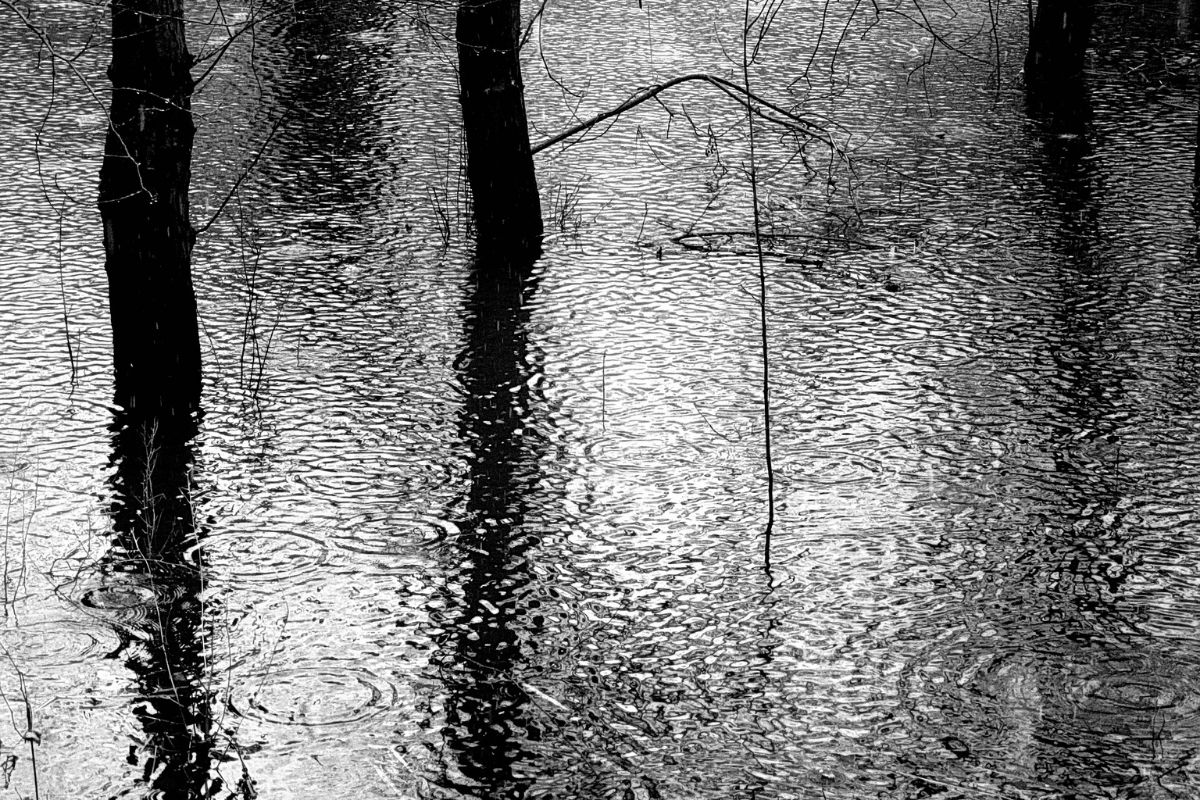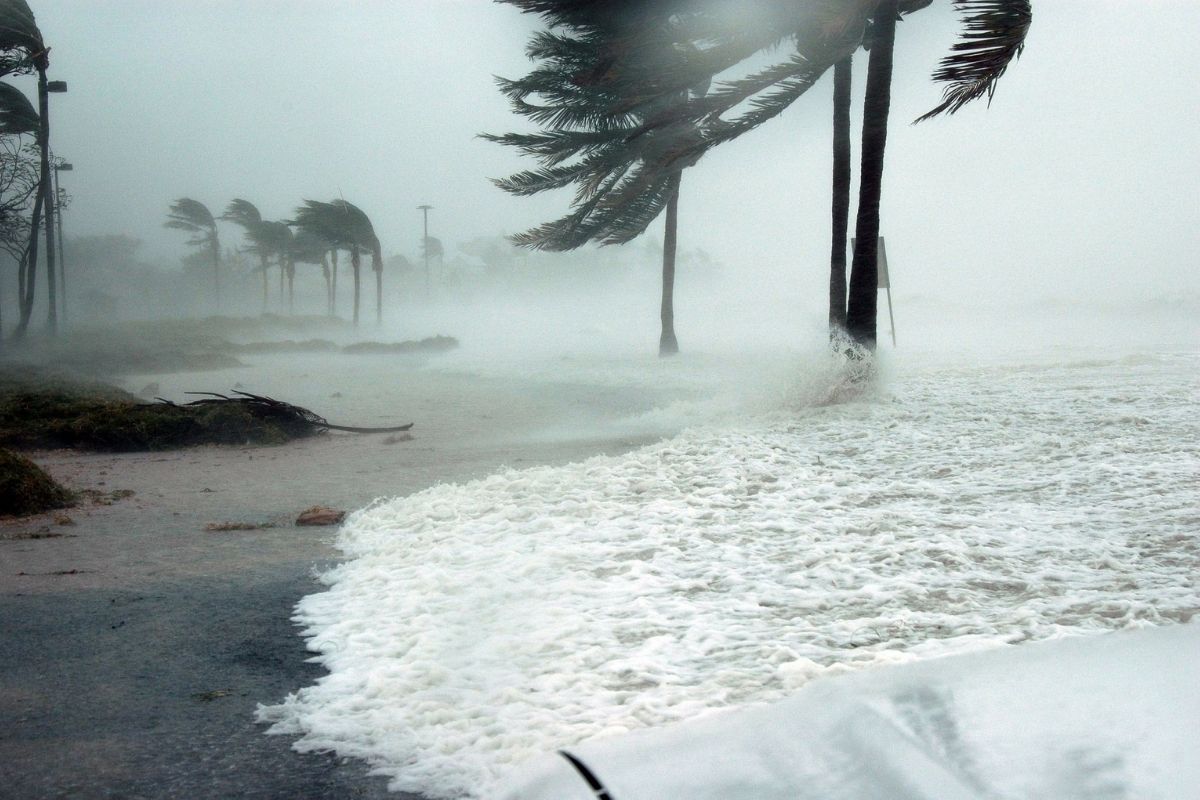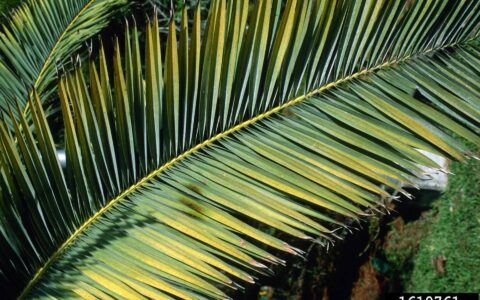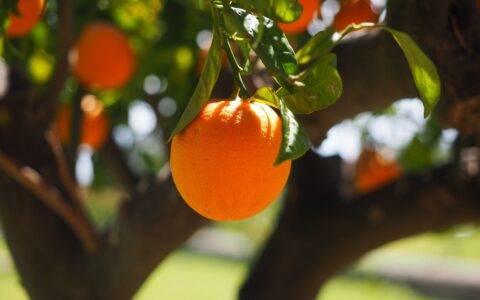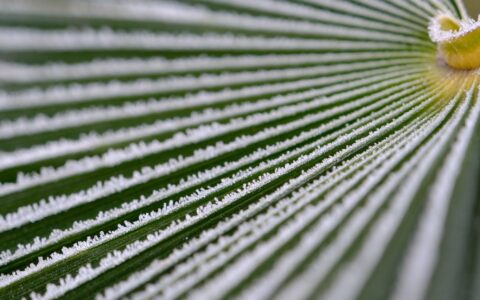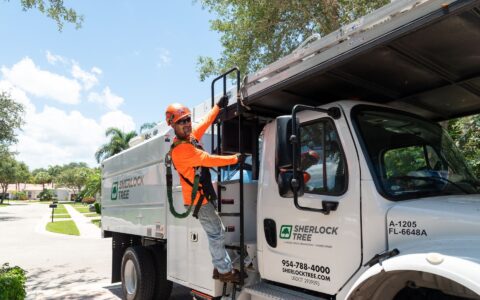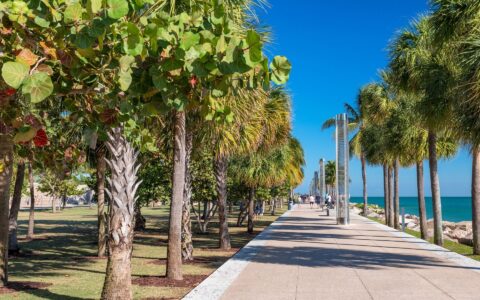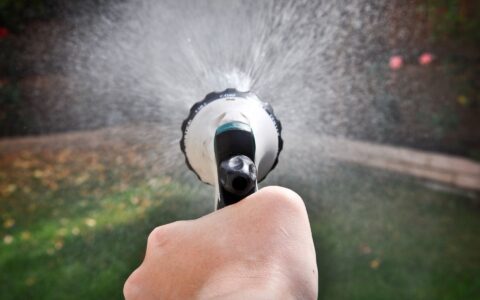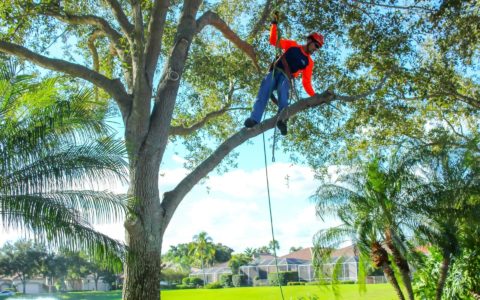South Florida’s low, flat landscape is prone to flooding after storm events, including tropical storms and hurricanes. Many homeowners find that their trees and other landscape plants are surrounded by standing water after these events, often for several days or more. What happens to those flooded trees, and whether they even survive being inundated with water, depends on what you do before the water arrives and what you do after floodwater recedes.
In this article, we describe:
- how to minimize the risk of flood damage to your trees,
- what happens to your trees when they’re flooded,
- steps you can take to help your trees after a flood,
- how to recognize signs of long-term flood damage to trees, and
- a list of trees that can tolerate standing water and/or storm surge (saltwater).
Prevent Flood Damage to Trees
Prevention is always the best cure! Whenever possible, it’s better to minimize the risk of flooding than it is to try to fix the damage afterward.
Noticing where water pools on your property is the first step in preventing your trees from suffering from water damage. If water tends to sit in one place after a rainfall, try to divert the water away from that area. Swales and drainage systems can also be installed to help water flow away from your property (just don’t direct it to your neighbor’s property!).
If you live next to a canal, avoid planting anything in the right of way area that could obstruct the flow of water. The South Florida Water Management District allows property owners to use the right of way, with proper authorization, as long as it doesn’t interfere with flood control operations.
What To Do If Your Trees Are in Standing Water
If your trees are flooded (or in saturated soil, such as those that are consistently over-watered), the best thing you can do is wait. If it’s possible to divert some of the water elsewhere, try to do that, but otherwise, it is a “wait and see” situation. Eventually, the water will evaporate or recede to the point that you can evaluate the damage.
What To Do After Floodwater Recedes
It’s tempting to wade into the water to evaluate your tree (or try to save it), but there’s nothing you can do until the water has gone. At that point, there are many things you can and should do to help your trees survive.
Remove Sediment
After all (or most) of the water has drained away, remove any dirt, sediment, or trash that may have been deposited. Check carefully around your trees to make sure there isn’t a layer of sediment over the tree’s roots (roots extend at least as far as the tree’s branches). A sediment layer of as little as 3 inches can reduce oxygen to the tree’s roots, essentially suffocating it.
Cover Exposed Roots
Severe flooding, particularly in windy conditions or in areas with strong currents or waves, can erode the soil around tree roots. Exposed roots make trees more vulnerable to being uprooted and increase the stress on the tree. Replace any soil that’s been washed away, being sure to fill any gaps underneath the roots as well.
Remove Damaged Branches
After the tree bark has fully dried, prune out any broken, diseased, or damaged branches. Pruning while the bark is still wet can increase the risk of infection by opportunistic pathogens.
Temporarily Remove Mulch
If you have any mulch around your trees, temporarily remove it. Mulch is used to retain moisture in the soil, so removing it can help more oxygen get to your trees as the ground dries out. Once the soil has fully drained, you can replace the mulch to help suppress weeds and conserve moisture.
Inspect for Signs of Leaning
Inspect all trees to see if they’re leaning and check the ground for signs that the tree may be partially uprooted. If you see exposed roots, cracks, or fissures in the soil, if the ground is higher on one side of the tree than the other, or if the tree is leaning, call a certified arborist ASAP for a complete inspection. It may be possible to straighten smaller trees, but larger trees with disturbed roots may need to be removed.
Maintain Tree Health
Don’t fertilize your tree, as more nutrients won’t help at this point. Instead, do everything you can to keep your tree as healthy as possible. The water and lack of oxygen was a stressor to your trees, so it’s best to remove any other causes of stress.
Flood Areas Damaged by Saltwater
It may seem counterintuitive to pour more water on an area that has already been flooded. However, if your landscape was flooded by storm surge, you may need to flush the salt from the soil. When the ground has partially dried, run a garden hose or dump pails of water around tree roots to flush out the salt.
Signs of an Overwatered or Drowning Tree
The effects of flooding (or overwatering) may not be visible on your trees for a while.
Things to look for include:
- Yellowing (chlorotic) leaves
- Premature loss of leaves
- Smaller leaves than usual
- Watersprouts growing from the base or trunk of the tree
- Dieback of branches in the tree canopy
- Brown, dry leaves
Even if these signs don’t appear, the loss of oxygen to the tree means that the tree is already stressed, leaving it more susceptible to attacks from pests or diseases.
Note that the signs of an overwatered tree are very similar to those of an underwatered tree. That’s because both lead to the same result – not enough water being absorbed by the tree’s roots and distributed throughout the canopy. If you’re not sure which is affecting your trees, call in a certified arborist for an inspection.
How Standing Water Affects Trees
The roots of a tree are vital to the tree’s health. They not only stabilize the tree through strong winds, they also bring food, moisture, and oxygen to the tree. Well-aerated soil has plenty of oxygen for the roots to send to the rest of the tree.
When the soil becomes saturated with water, oxygen is replaced with water. Without the oxygen needed for survival, the tree “suffocates” and begins to exhibit the signs mentioned above, such as drying or yellowing leaves.
Whether or not your trees survive being flooded depends to some extent on when the flooding occurs.
- Most tree species are able to withstand several months of flooding while they’re dormant (not actively growing), as long as water recedes before they begin to grow.
- Flooding while trees are actively growing can be much more damaging. Sensitive tree species can die after only a week of being underwater; others will suffer major, long-term damage from which they may not recover.
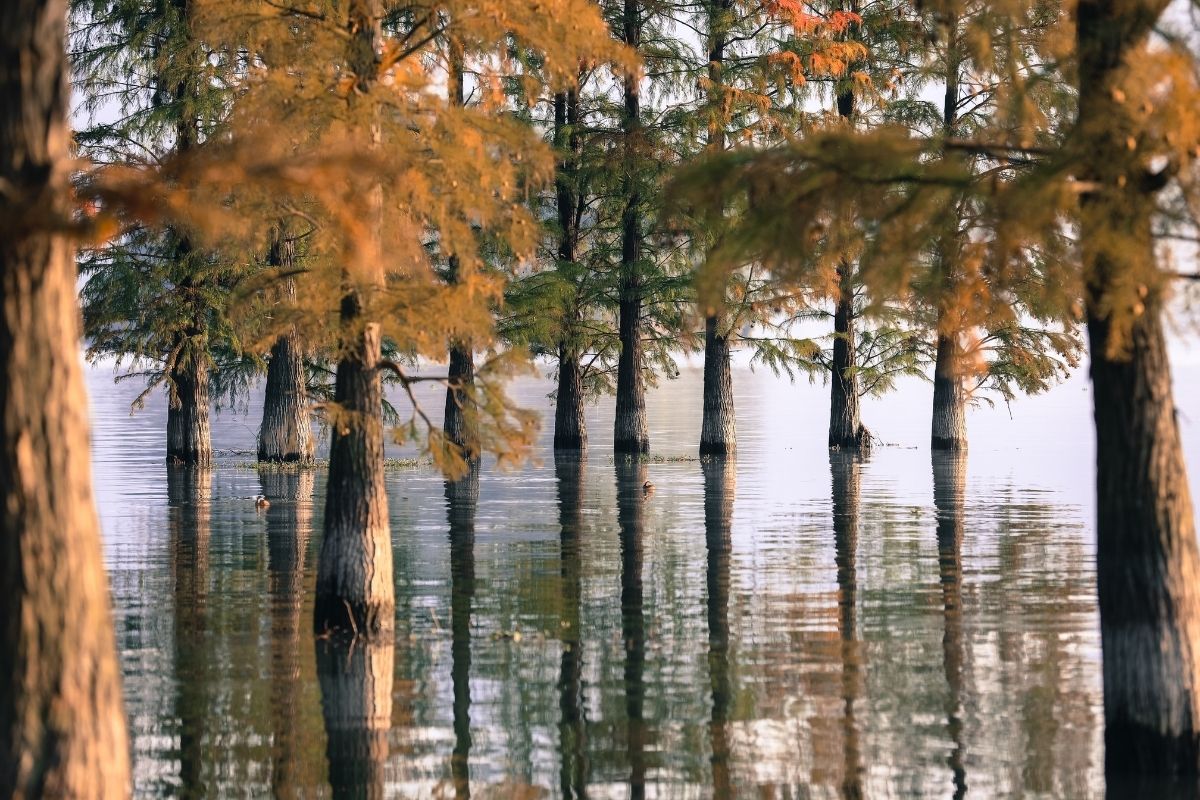
Choosing trees that can tolerate flooding and saltwater is the best prevention against flooding damage
Choose Trees That Tolerate Flooding and Storm Surge
If it’s not possible to divert standing water or your property is prone to frequent flooding, consider replacing your trees with species that can handle wet soil and/or inundation with floodwater.
If your property is close to the coast and susceptible to storm surge, choose trees and plants that are salt-tolerant. Salt is extremely damaging (and even fatal) to most plants, so plan your landscape to minimize the likelihood of saltwater killing your trees and shrubs.
The trees below grow well in South Florida and can tolerate a moderate to high degree of flooding and saltwater. Those marked with a * shouldn’t be planted near coastal areas as they are not salt-tolerant.
- Paurotis Palm (Acoelorrhaphe wrightii)
- Florida Thatch Palm (Thrinax radiata)
- Coconut Palm (Cocos nucifera)
- Cypress (Taxodium spp.)*
- Live Oak (Quercus virginiana)*
- Gumbo Limbo (Bursera simaruba)
- Sea Grape (Coccoloba uvifera)
- Strangler Fig (Ficus aurea)
- Cocoplum (Chrysobalanus icaco)
- Mastic (Mastichodendrum foetidissimum)
- Cabbage Palm (Sabal palmetto)
- Dahoon Holly (Ilex cassine)*
- Pond Apple (Annona glabra)*
- Black Ironwood (Krugiodendron ferreum)
- Stoppers spp. (Eugenia, Myrcianthes)
- Buttonwood (Conocarpus erectus)
- Red Bay (Persea borbonia)*
- Royal Palm (Roystoneaspp.)
- Jamaican Caper (Capparis cynophallophora)
Learn more about hurricane-resistant trees to plant in South Florida >>
Long-Term Care of Flooded Trees
For some trees, long-term care will be necessary. While fertilizer shouldn’t immediately be applied to a waterlogged tree, your tree will likely benefit from deep-root fertilization later. Other treatments can include air spading to increase the oxygen in the soil, pruning out damaged or diseased wood, mulching, and regular maintenance.
The amount of time a tree spends with its roots underwater can greatly impact its chance of recovery. Most trees will be able to bounce back with some TLC if the roots were underwater for less than 7 days. Some trees will be able to survive even if they were waterlogged for closer to 30 days.
The outlook for flooded trees depends on a variety of factors, such as:
- the tree species,
- how long they were underwater,
- their condition before flooding occurred,
- whether any other damage occurred (such as during a hurricane),
- the type and condition of the surrounding soil, and
- the quality of care your trees receive after a storm.
We Can Help
If your trees have been flooded for a week or more, it’s best to call in a certified arborist for a professional tree consultation.
The certified arborists at Sherlock Tree Company are experienced in dealing with trees that have suffered flood damage. We can diagnose any issues with your trees and suggest a plan for how to help them become healthy again.
If your tree is, sadly, beyond saving, we can remove the tree and help you determine the best type of tree to replace it with.
Call Sherlock for quality tree services
Whether you're looking for specific tree care services, such as palm trimming, tree removal, or disease treatments, or would like one of our Arborists to examine your trees to identify any issues and recommend options, we're always here for you! Just give us a call at 954-788-4000 to set up an appointment.
- « Previous
- 1
- 2
- 3
- Next »
SEE MORE ARTICLES
Looking for more?
We've got you covered with a monthly newsletter full of tips, resources, updates, how-to's, and other helpful information about trees and landscapes in South Florida!

